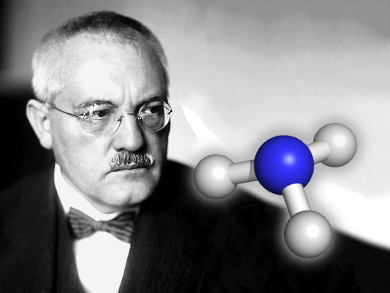Carl Bosch was born in Cologne, Germany, on August 27, 1874. He studied metallurgy and mechanical engineering at the Technische Hochschule in Charlottenburg (now Technical University of Berlin, Germany) and Chemistry at the University of Leipzig, Germany. He started work at the Badische Anilin- und Sodafabrik (today BASF SE) in Ludwigshafen, Germany, in 1899.
There, he transformed Fritz Haber’s high-pressure synthesis of ammonia into an industrial process of unparalleled importance. He and his team overcame the considerable challenges of constructing an apparatus that could withstand the high pressures, finding a stable, affordable, and sufficiently active catalyst, and coming up with a method of supplying pure hydrogen gas, all in less than five years. The first ammonia plant was built in Oppau, near Ludwigshafen, in 1913. On September 21, 1921, an ammonium nitrate explosion destroyed the plant and large parts of the town.
The ammonia produced using the Haber–Bosch process was used for explosives and fertilizers, the former an important factor in World War I, the latter with a dramatic impact on humanity’s ability to grow food and sustain a growing population to this day. It is estimated that about half of the nitrogen input in agriculture originates from the Haber–Bosch process, and the manufacture of nitrogen fertilizers accounts for about 1–2 % of the world’s annual energy consumption.
Bosch was appointed Managing Director of the Badische Anilin- und Sodafabrik in 1919. In 1935, he was appointed Chairman of the Board of Directors of IG Farben, which had been founded in 1925 in a merger of six German chemical companies. Among many other honors, he received the Nobel Prize in Chemistry in 1931 together with Friedrich Bergius “in recognition of their contributions to the invention and development of chemical high-pressure methods”. From 1937 to 1940, he was President of the Kaiser Wilhelm Society for the Advancement of Science (today’s Max Planck Society). Bosch died on April 26, 1940, in Heidelberg, Germany.
References
- Nobel Lectures, Chemistry 1922 – 1941,
Elsevier Publishing Company, Amsterdam, 1966.
ISBN: 978-981-02-3406-5 - Enriching the Earth: Fritz Haber, Carl Bosch, and the Transformation of World Food Production,
Vaclav Smil,
MIT Press, Cambridge, 2000.
ISBN: 978-0-262-19449-5
Carl Bosch is the answer to Guess the Chemist (40).
Also of Interest
- “We Create Chemistry for a Sustainable Future”: Chemistry Creates Sustainable Solutions for a Growing World Population,
A. Kreimeyer, P. Eckes, C. Fischer, H. Lauke, P. Schuhmacher,
Angew. Chem. Int. Ed. 2015.
DOI: 10.1002/anie.201409941 - 80th Anniversary of Fritz Haber’s Death,
ChemistryViews 2014.
Fritz Haber, who received the 1918 Nobel Prize in Chemistry for the synthesis of ammonia from its elements, died January 29, 1934. - Electride Ammonia,
David Bradley,
ChemistryViews 2012.
A new process for making ammonia could reduce the overall energy costs in the manufacture of this crucial chemical. - A Rival for the Haber-Bosch Process,
Mike Rowan,
ChemistryViews 2011.
Biological nitrogen fixation catalyzed by nitrogenase could rival the Haber–Bosch process according to US researchers.




